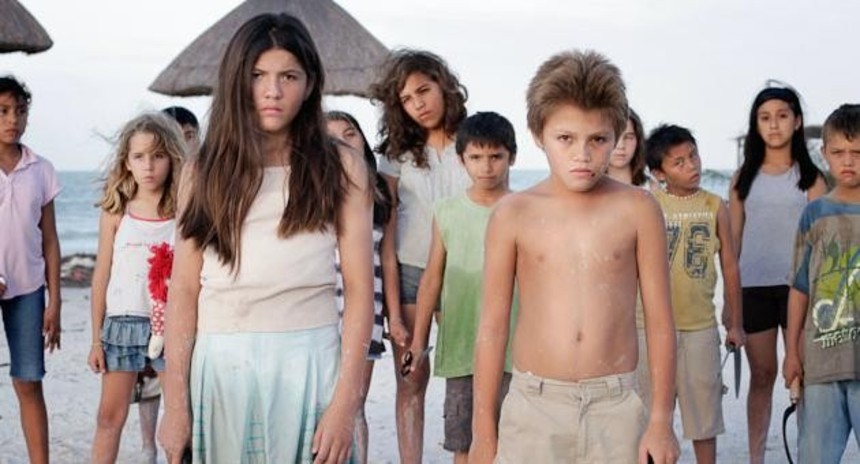TIFF 2012 Review: COME OUT AND PLAY Drops the Ball

Other than a missing prologue and a swapping of Spain for Mexico, it is a shot for shot remake of Who Can Kill a Child?, only with poorer actors. It also demonstrates how tone and editing, when off by the barest of whispers, can break a film in terms of audience goodwill or suspension of disbelief. I hope that audiences do not let the bad experience of this 2012 version sully the original film, now matured to a middle-aged 35 years of age, which has not diminished a bit in terms of executing on its premise. The new one cannot even get itself started.
Francis and Beth are in Mexico on vacation from their kids just before Beth gives birth to their third child. Getting out of busy carnival time on the mainland to the sleepy island town of Punta Hueca for some peace and quiet proves to be ill advised. When the couple arrive at the docks in a rented boat, children playing on the dock either ignore them or give them creepy stares. Otherwise, it seems that every house on the island is deserted, with signs that everyone left in a big hurry. Sweltering in the hot sun, the couple wander around with that uneasy feeling, but willing to make the best of bad circumstances until the creepy kids start showing signs of more tangible menace.
A very slow build, the remake mimicking but not matching the superior uneasy pacing of the original, eventually yields to the film's chief question, "Who can kill a child?" literally spoken by one of the few resident adults that eventually come out of the woodwork, only to be dragged away by their own children, powerless to act, even though they are aware that their kids have gone into some sort of blood-frenzy. Calling to mind George Romero's Night of the Living Dead, particularly the scene with the daughter in the basement, but also the final ironic (and iconic) shot of the authorities come for judgement, the film is even more keen on taking on the imagery of Alfred Hitchcock's The Birds, replacing the silent avian stares with eerie 8-year-old children.
A very slow build, the remake mimicking but not matching the superior uneasy pacing of the original, eventually yields to the film's chief question, "Who can kill a child?" literally spoken by one of the few resident adults that eventually come out of the woodwork, only to be dragged away by their own children, powerless to act, even though they are aware that their kids have gone into some sort of blood-frenzy. Calling to mind George Romero's Night of the Living Dead, particularly the scene with the daughter in the basement, but also the final ironic (and iconic) shot of the authorities come for judgement, the film is even more keen on taking on the imagery of Alfred Hitchcock's The Birds, replacing the silent avian stares with eerie 8-year-old children.
Speaking of the Master of Suspense, Come Out And Play reminds me of Gus Van Sant's 1998 shot for shot remake of Psycho in that something is arguable lost in such an academic experiment. Belarussian single-moniker director Makinov is most certainly not the director that Gus Van Sant is, and while Who Can Kill a Child? is not quite at the artisanship level of Psycho, the quality gap between original and remake is even greater; each shot diminished, each effect or reaction lesser. By the time we get to the show-stopper involving Beth's pregnancy in this 2012 version, the ball has been dropped so hard that it renders it sadly inert.
When you remake these sorts of films, there perhaps should be more consideration given to "Why now?" and "How have times changed?" in order to provide a remake with some relevance. Note the classic examples of great remakes, along the lines of The Thing, Invasion of the Body Snatchers and The Fly. A rather lazy shot by shot re-filming, even if the original is not that well known, surely is the easiest route. Cutting out the exploitive and context-establishing opening sequence of atrocities (perhaps the reason why so few have seen the 1976 version), which suggested a karmic reason for the innocent children acquiring evil and punishing the adults, seems an equally poor choice.
In the end, that is what Come Out And Play is both in the context of the characters in the film, as well as the filmmaking outside: a series of poor choices.
When you remake these sorts of films, there perhaps should be more consideration given to "Why now?" and "How have times changed?" in order to provide a remake with some relevance. Note the classic examples of great remakes, along the lines of The Thing, Invasion of the Body Snatchers and The Fly. A rather lazy shot by shot re-filming, even if the original is not that well known, surely is the easiest route. Cutting out the exploitive and context-establishing opening sequence of atrocities (perhaps the reason why so few have seen the 1976 version), which suggested a karmic reason for the innocent children acquiring evil and punishing the adults, seems an equally poor choice.
In the end, that is what Come Out And Play is both in the context of the characters in the film, as well as the filmmaking outside: a series of poor choices.

Do you feel this content is inappropriate or infringes upon your rights? Click here to report it, or see our DMCA policy.





